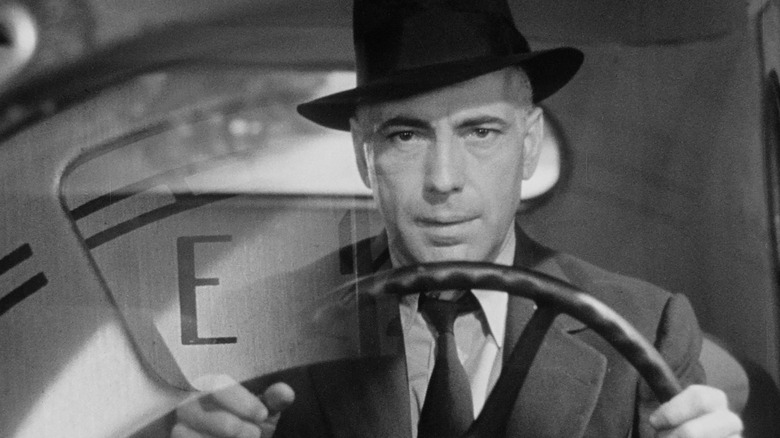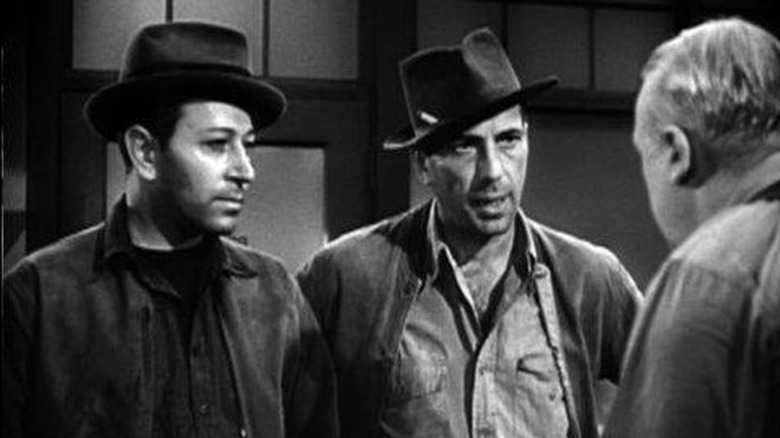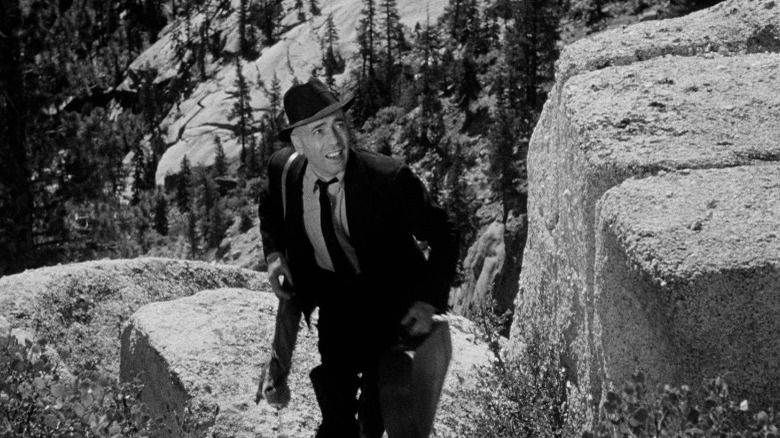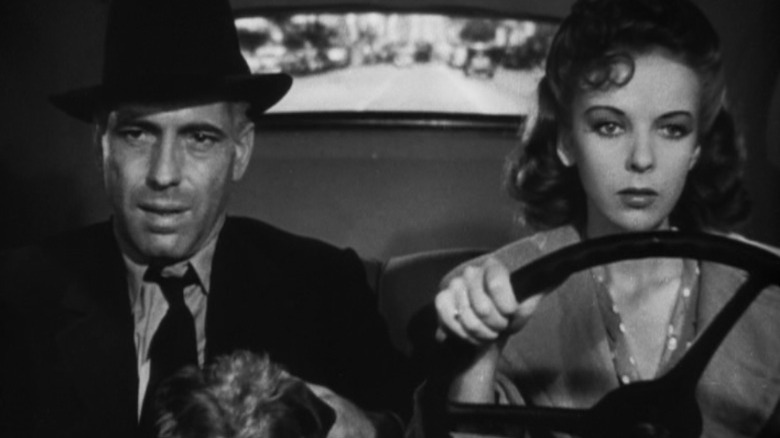How High Sierra Made Humphrey Bogart A Bonafide Movie Star
Humphrey Bogart is one of the great icons of classic Hollywood. His trademark snarl and surprising romantic heroism sealed his legendary status in pop culture at large. For how inescapable his impact was, it's hard to imagine a period in sound film before him. But his rise to stardom took time. He wasn't exactly gunning down Nazis in Casablanca in his first year on the Warner Bros. lot.
What he was doing for most of his '30s performances was playing the background gangster in the studio's many crime melodramas. In movies with titles like "Bullets or Ballots" and "Racket Busters," audiences could rely on him showing up, grimacing, and probably dying in a moral way by movie's end. If he wasn't in a gangster movie, he could be oddly miscast, such as his appearance as an Irish stable master in the Bette Davis weepie "Dark Victory." No role was too small for him to take, but he definitely shined in some more than others.
His takeover of Hollywood may not have come quickly, but there's a clear dividing line between his supporting roles in gangster movies and the more complex roles for which he would come to be known: 1941's "High Sierra." After that movie, which would come to be seen as a marker of the "death of the gangster movie" (and a transition to film noir), his talent and charisma were hard to ignore. The roles came quickly then — just a movie or so later, he played Sam Spade in the detective classic "The Maltese Falcon."
Climbing the ranks
According to A.M. Sperber and Eric Lax's "Bogart" biography, the actor had begun complaining about his roles after several years of frustrating bum parts. Speaking with Warner Bros. super-producer Hal B. Wallis (who would go on to oversee the legendarily chaotic Bogart-starring "Casablanca"), he found out where he stood in the studio's actor hierarchy. Wallis put him behind George Raft, Edward G. Robinson, and Paul Muni.
Bogart allegedly replied, "All I do is bump off Muni and we all move up a step."
When it came to Roy Earle, the plum role at the center of "High Sierra," he didn't need to bump off anybody. He just had to stay in line, moving up when Muni, star of 1932's "Scarface," declined to renew his contract with Warner Bros. Per Sperber and Lax, Robinson was seen as past the peak of his stardom. But George Raft, the blandly handsome actor and dancer from Hell's Kitchen, still held rank over Bogart.
As Wallis claimed in his 1980 autobiography "Starmaker," George Raft was often offered gangster parts, and "time and time again he turned them down" to avoid public accusations of being connected. A shrewd actor like Bogart understood that Roy Earle, the protagonist of "High Sierra," was no ordinary gangster character. That might have been why he convinced Raft that he was. According to Sperber and Lax, he told Raft the complex and tragic lead of "High Sierra" was just another heavy, which led to the actor refusing the role in no uncertain terms. That left Bogart.
Bogart in High Sierra
Roy Earle (Humphrey Bogart) was no heavy.
As adapted from W. R. Burnett's 1940 novel by John Huston (the eventual director of "Treasure of the Sierra Madre" and other Bogart classics), "High Sierra" deals with Roy, fresh out of jail, signing on to another heist. He meets the troubled Marie (Ida Lupino), who tags along with one of the men on the robbery and falls in love with Roy even as he becomes a wanted man. The movie's a swamp of regrets and fatalism, and while it borrows some plot elements from the then-oversaturated gangster genre, it still has the feeling of something new and innovative.
"High Sierra" allows Bogart to play the romantic hero, doing it convincingly by letting him walk the line between charm and terror. While plotting the robbery, he pays for the surgery of young, disabled Velma (Joan Leslie), a good girl who couldn't be further from the criminal lifestyle. He's a complex guy.
As much as the movie concerns itself with the robbery, it's even more about Roy's adoration for Velma, and his consequent desire for redemption, which fails to stick. Ultimately, Marie sticks by his side. When the robbery's failure leaves the two of them on the run, Marie ends up deeply in love with Roy, who would rather die than go back to jail. As in the gangster movies of old, he is killed by law enforcement and the credits roll. The difference here comes down to the deeper, more existential feelings the movie summons through Bogart's performance — funny, scary, and searching.
Sunset of the gangster genre
Many things changed for Humphrey Bogart in the wake of "High Sierra." For one, his relationship with John Huston (who, according to Sperber and Lax's "Bogart," was "delighted" when George Raft refused the role) meant that they would rise together, with the young writer-director casting Bogart in a number of high-profile films, as well as testing his patience. It was also a proof of Bogart's nascent stardom, utilizing the screen presence he forged in the toil of endless B-movies.
Those B-movies almost became a problem during the movie's filming. Bogart was excited to finally be given a starring role worth his talents. Per Sperber and Lax, producer Hal B. Wallis decided to downplay him in the marketing, focusing instead on the newly sensational Ida Lupino, whose performance in 1940's "They Live By Night" (also starring Bogart in a much smaller role) proved hugely successful. She got top billing on "High Sierra."
Ultimately, Bogart was undeniable in the movie, and he and Lupino got high praise for their respective work. To watch the movie now is to forget about any fights over billing, and to see it for what it is: the movie that launched Bogart to stardom for most of the next decade.
Stefan Kanfer's "Tough Without a Gun" claims "High Sierra" "marked the sunset of the gangster genre." It led the way forward to a cinematic world of stark moral quandaries, where bad men were rarely just that. Where Bogart would never have to play a bit part as a background heavy ever again.



